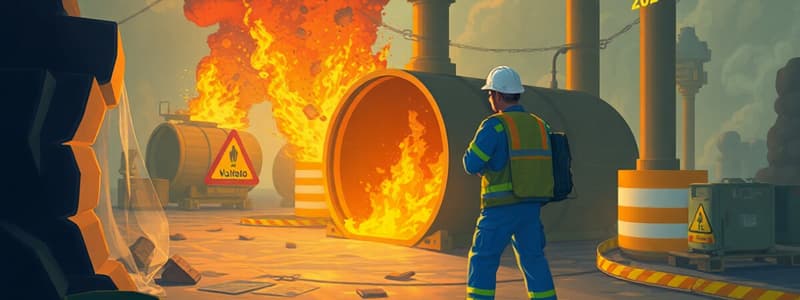Podcast
Questions and Answers
What is the primary focus of the content provided?
What is the primary focus of the content provided?
- A reference and study guide for safety professionals (correct)
- Legal guidelines for safety practices
- An introduction to safety regulations
- A comprehensive history of safety measures
Who is the author of the Safety Professional's Reference and Study Guide?
Who is the author of the Safety Professional's Reference and Study Guide?
- The U.S. Government
- CRC Press
- W. David Yates (correct)
- Taylor & Francis
Which of the following is a requirement mentioned for reproducing content from the book?
Which of the following is a requirement mentioned for reproducing content from the book?
- Oral permission from the author
- No permission is necessary
- License from the Library of Congress
- Written permission from the publishers (correct)
What type of material does the book contain information from?
What type of material does the book contain information from?
In what year was the third edition of the Safety Professional's Reference and Study Guide published?
In what year was the third edition of the Safety Professional's Reference and Study Guide published?
What is the ISBN-13 number for the hardback edition of the book?
What is the ISBN-13 number for the hardback edition of the book?
Which organization is mentioned as providing licenses for photocopying rights?
Which organization is mentioned as providing licenses for photocopying rights?
What notice is included regarding product names or corporate names in the book?
What notice is included regarding product names or corporate names in the book?
What type of hazards are associated with hazardous materials?
What type of hazards are associated with hazardous materials?
Which regulatory act was established to govern the disposal of hazardous waste?
Which regulatory act was established to govern the disposal of hazardous waste?
What physical safety hazard is most likely to occur with materials that are water-reactive?
What physical safety hazard is most likely to occur with materials that are water-reactive?
What is the focus of the Emergency Planning and Community Right-to-Know Act (1986)?
What is the focus of the Emergency Planning and Community Right-to-Know Act (1986)?
Which term describes materials that can undergo a rapid and violent reaction when exposed to heat or fire?
Which term describes materials that can undergo a rapid and violent reaction when exposed to heat or fire?
What does the Domino Theory primarily focus on in accident causation?
What does the Domino Theory primarily focus on in accident causation?
Which of the following is NOT a component of Heinrich’s Axioms of Industrial Safety?
Which of the following is NOT a component of Heinrich’s Axioms of Industrial Safety?
What aspect does the Human Factors Theory emphasize in accident causation?
What aspect does the Human Factors Theory emphasize in accident causation?
What is the main purpose of accident investigation procedures?
What is the main purpose of accident investigation procedures?
Which analysis method is used to evaluate the potential failures in a system?
Which analysis method is used to evaluate the potential failures in a system?
In the context of accident investigation, what is the objective of the fact-finding process?
In the context of accident investigation, what is the objective of the fact-finding process?
Which of the following describes Systems Theory in accident causation?
Which of the following describes Systems Theory in accident causation?
Which countermeasure is used to address Safety Management Errors?
Which countermeasure is used to address Safety Management Errors?
What does the term 'near-miss relationship' refer to in accident investigation?
What does the term 'near-miss relationship' refer to in accident investigation?
What is the primary purpose of using ventilation in a space?
What is the primary purpose of using ventilation in a space?
Which type of ventilation specifically addresses removing contaminants at their source?
Which type of ventilation specifically addresses removing contaminants at their source?
What principle is essential for determining the airflow requirements for a given space?
What principle is essential for determining the airflow requirements for a given space?
Which device is commonly used to measure airflow velocity in ventilation systems?
Which device is commonly used to measure airflow velocity in ventilation systems?
What does calculating static pressure in ventilation primarily help determine?
What does calculating static pressure in ventilation primarily help determine?
What is the consequence of inadequate ventilation when trying to control vapor concentrations in a room?
What is the consequence of inadequate ventilation when trying to control vapor concentrations in a room?
Which type of hood is specifically designed to capture emissions from materials or components at ground level?
Which type of hood is specifically designed to capture emissions from materials or components at ground level?
What does the term 'capture velocity' refer to in local exhaust ventilation?
What does the term 'capture velocity' refer to in local exhaust ventilation?
In ventilation calculations, what is the importance of knowing the purge rate?
In ventilation calculations, what is the importance of knowing the purge rate?
Which of the following factors is essential for calculating airflow in ventilation systems?
Which of the following factors is essential for calculating airflow in ventilation systems?
What is the primary principle governing the relationship between fluid flow and pressure in a fluid system?
What is the primary principle governing the relationship between fluid flow and pressure in a fluid system?
Which of the following factors is not a component of hydrostatic pressure?
Which of the following factors is not a component of hydrostatic pressure?
What defines the difference in pressure between two points in a fluid due to friction?
What defines the difference in pressure between two points in a fluid due to friction?
Under which condition does Torricelli's Law apply?
Under which condition does Torricelli's Law apply?
In the context of velocity head, which formula is most accurately represented?
In the context of velocity head, which formula is most accurately represented?
When considering flow rates in a hydraulic system, which element is essential for calculating pressure drops?
When considering flow rates in a hydraulic system, which element is essential for calculating pressure drops?
What is the relationship described by head pressure in a fluid at rest?
What is the relationship described by head pressure in a fluid at rest?
What happens to velocity pressure at constant laminar velocity?
What happens to velocity pressure at constant laminar velocity?
What key information must be remembered regarding Bernoulli’s principle?
What key information must be remembered regarding Bernoulli’s principle?
Flashcards are hidden until you start studying
Study Notes
Safety Professional's Reference and Study Guide
- The third edition of the Safety Professional’s Reference and Study Guide was published in 2020 by Taylor & Francis Group.
- The book contains information about ventilation (covered in chapter 7), hydrostatics and hydraulics (discussed in chapter 8), and accident causation and investigation techniques (described in chapter 17).
- Chapter 21 covers hazardous materials and waste management.
- Information about hazardous materials and waste management covers the Resource Conservation and Recovery Act (RCRA) of 1976, the Comprehensive Environmental Response, Compensation, and Liability Act (CERCLA) of 1980, the Superfund Amendment and Reauthorization Act (SARA) of 1986, the Toxic Substances Control Act (TSCA) of 1976, the Emergency Planning and Community Right-to-Know Act (EPCRA) of 1986, the Federal Insecticide, Fungicide, and Rodenticide Act (FIFRA) of 1972, the Asbestos Hazard Emergency Response Act (AHERA) of 1986, and the Hazard Communication Standard (HCS) (29 CFR 1910.1200).
- RCRA outlines hazardous waste generator categories and compliance with the legislation.
- CERCLA addresses the cleanup of abandoned hazardous waste sites.
- SARA amended CERCLA and included provisions for emergency planning, community right-to-know, and toxic chemical release reporting.
- TSCA regulates the manufacture, processing, distribution, use, and disposal of chemical substances.
- EPCRA requires facilities to develop emergency response plans and to report chemical releases.
- FIFRA regulates pesticides and their use.
- AHERA sets standards for asbestos abatement.
- The Hazard Communication Standard (HCS) ensures workers are protected from exposure to hazardous chemicals.
Studying That Suits You
Use AI to generate personalized quizzes and flashcards to suit your learning preferences.



